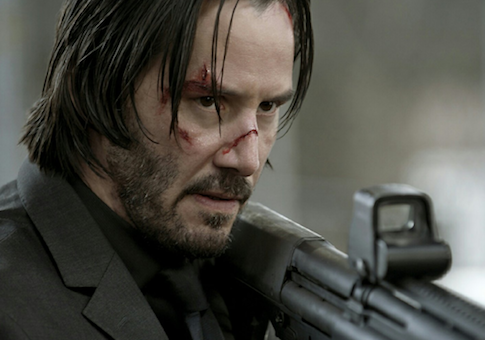As with John Wick—not a box office behemoth, exactly, but critically acclaimed and a hit on home video—it's the little touches, the minute exercises in world building, which make John Wick 2 stand out.
For instance, there's the switchboard that serves as the central nervous system of the mysterious society of hit men that make up Wick's wicked fraternity. Its employees are all female, all ages, all tatted up: It's like a retirement community for Suicide Girls in addition to serving as a reservoir of knowledge and a conduit for funding a worldwide network of killers for hire.
And then there's The Continental, the hit man hotel owned and operated by Winston (Ian McShane), the only man (and actor) who can get away with calling John Wick (Keanu Reeves) "Jonathan." Well, one of two, I suppose: In the sequel, we learn The Continental is a chain of sorts. The manager of its Italian branch (Franco Nero) also deploys "Jonathan," while other employees—such as the Sommelier (Peter Serafinowicz), who dabbles in ordnance as well as aperitifs—stick to "Mr. Wick."
Perhaps most important is the MacGuffin that drives John Wick 2's plot: a marker called in by Santino D'Antonio (Riccardo Scamarcio). A literal marker, a device imprinted with John Wick's bloody thumb print that signifies a debt to be repaid at the time of the marker's holder's choosing. Like the gold coins exchanged by the seemingly endless number of assassins who enter and exit The Continental, the marker is an archaic symbol of another age, a physical manifestation of the importance of keeping one's word.
When Wick refuses to accept the marker, Santino blows up his house. (Don't worry, puppy lovers: the dog he acquired at the end of the first film survives.) And, as Winston makes clear, Wick pretty much had it coming. Wick traded that marker for his freedom from The Business and then went back on his word when Santino called in his chit. In a world where laws are meaningless and dollars are traded for blood without a second thought, a man's word is all that matters.
Well, a man's word and his way with weaponry.
Fortunately, John Wick's way with weapons is much stronger than his word. Headshot after headshot reduce grey matter to pink mist, a Bolshoi of blood and bits of bone brought to life by director Chad Stahelski. In all honesty, I slightly preferred the action in the first film to this one—the original's fluidity was a welcome antidote to a decade of Greengrassian shaky cam and chaos cinema; in addition to being less of a surprise, the camerawork feels slightly less steady this time around. And at 122 minutes, compared the original's 96, John Wick 2 feels a bit less lean.
These are niggling complaints, however, for a movie as fun and furious as John Wick 2. Virtually everything about the film is a delight, especially the cameos—McShane, of course, and Serafinowicz, but also Peter Stormare and Laurence Fishburne and Lance Reddick. Stormare and Fishbourne chew up scenery like Sean Spicer on an Orbit's bender, while Reddick is almost flashy in his reserve, an arched eyebrow at the madness surrounding him as The Continental's concierge prompting more laughs than any jape possibly could.
Wick's main rivals are Cassian (Common) and Ares (Ruby Rose), the bodyguards of Camorra heads Santino and Gianna D'Antonio (Claudia Gerini), respectively. Common has carved out a nice space for himself in the movie marketplace as a generic murderer, playing similar roles in Smokin' Aces, Street Kings, Wanted, and Run All Night. But he feels slightly out of place in the John Wick universe, a bit too blandly intense to really merit the screen time Cassian receives. Ruby Rose is much more suited for the proceedings: she looks something like a ventriloquist doll as the mute Ares, her short black hair pairing nicely with sharply tailored suits to give her a severe aesthetic befitting a rival to Wick.
In short: John Wick 2 is a worthy sequel to the best American action film of the 2010s, one that builds upon its predecessor without quite surpassing it.
